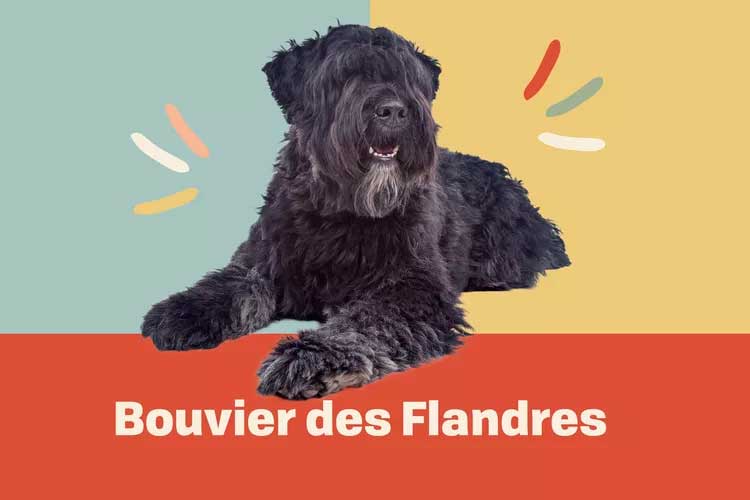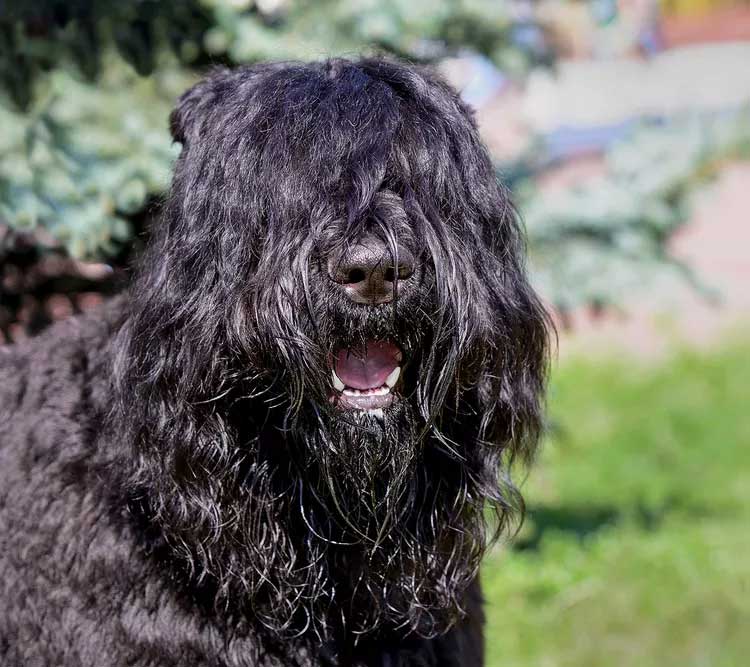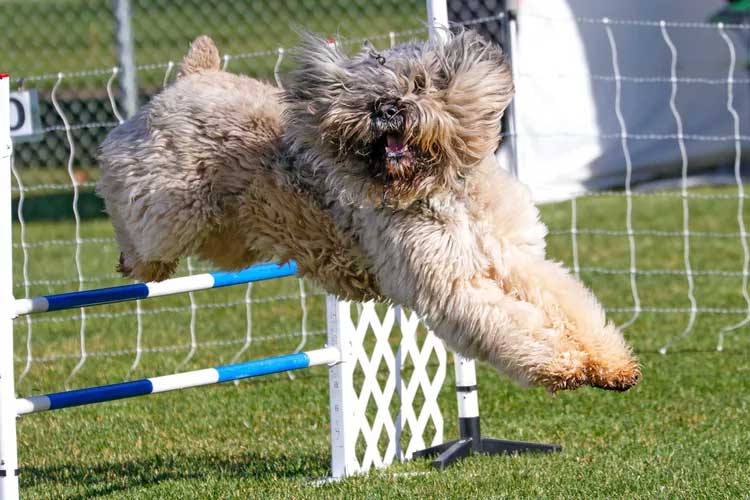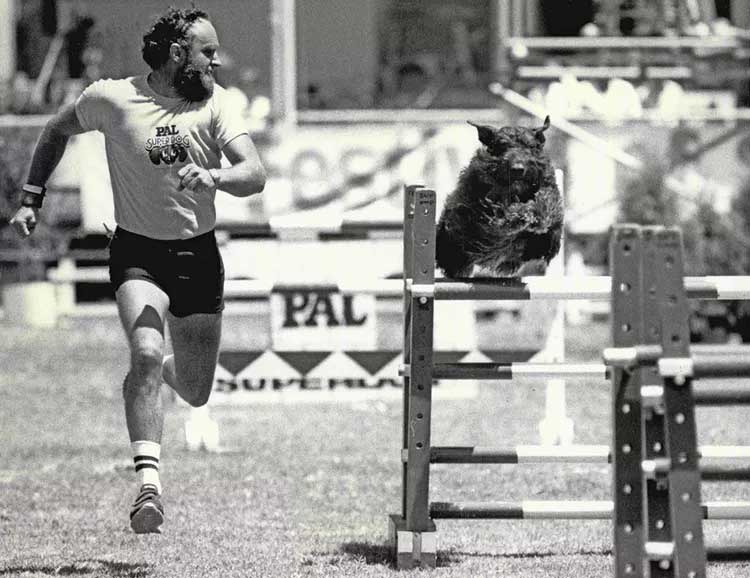Big, brainy, and boasting a shaggy double coat, the Bouvier des Flandres is a versatile working dog and family companion. But because of his intense grooming and activity needs, he’s not for everyone.

Bouvier des Flandres Overview
| OFFICIAL NAME | Bouvier des Flandres |
| COMMON NAME | Bouvier des Flandres |
| PET HEIGHT | 23 to 27 inches |
| PET WEIGHT | 70 to 110 pounds |
| LIFESPAN | 10 to 12 years |
| GOOD WITH | cats, children, dogs, families |
| TEMPERAMENT | aloof, gentle, playful, willful |
| INTELLIGENCE | high |
| SHEDDING AMOUNT | infrequent |
| EXERCISE NEEDS | high |
| ENERGY LEVEL | active |
| VOCAL LEVEL | when necessary |
| DROOL AMOUNT | low |
| BREED GROUP | herding |
| BREED SIZE | large (61-100 lbs.) |
| COAT LENGTH | medium |
| COLORS | black, fawn, gray |
| PATTERNS | brindle, flecked / ticked / speckled |
| OTHER TRAITS | cold weather tolerant, good hiking companion, high potential for weight gain, hypoallergenic, loves water, requires lots of grooming, strong loyalty tendencies |
Large and powerful with a shaggy, weather-proof double coat, the Bouvier des Flandres is a dog who can do it all. He was bred to be a versatile and hard-working farmhand, doing everything from herding livestock to churning butter (yep, you heard that right). Even as a family pet, he's happiest when given a job to do. And with a Bouvier in the house, you'll have a job to do as well—keeping his coat groomed and his distinctive beard clean is practically a 9–5 position, requiring time, patience, and a little elbow grease.
Appearance
With a thick, heavy beard and mustache, naturally tousled-looking coat, and overall commanding presence, the Bouvier des Flandres makes quite the first impression. And that's on top of his staggering size—this large dog breed can weigh 70–110 pounds. Add in his shaggy eyebrows and triangular ears, and, as they say, it's a look.Traditionally, the giant Bouvier des Flandres' ears are cropped, though the practice is controversial. According to the American Veterinary Medical Association, ear cropping is typically done for cosmetic reasons and has no proven health benefits. Plus, the procedure can be painful!

His signature coat, which comes in colors including black, fawn, salt and pepper, and brindle, has two distinct layers: An outer coat with rough, coarse fur, and a fine, dense undercoat. Put them together and you've got serious water-resistance—and a recipe for major mats if you don't take his grooming needs seriously. That rough coat might keep out water, but it rarely meets dirt and debris it doesn't want to take home.
Despite all that fur, his coat is low-dander and doesn't shed much. And while no dog is truly hypoallergenic, the Bouvier is considered the largest allergy-friendly breed and might be a good choice for some who sneeze around dogs.
Temperament
The Bouvier des Flandres was bred to work, and he's happiest when he has a job to do. "They were the working farmer's dog who was put in charge when the farmer left, and they took that job seriously," says Pilar Kuhn, owner of La Chanson Bouviers in Southern California.Bouviers are a member of the herding group, but their skills don't end with rounding up sheep. This versatile breed has impressive endurance and a long resume: He pulled carts, watched over livestock, and kept strangers off his owner's property. With all his talents, the Bouvier des Flandres is an independent spirit and not the right dog for everyone—especially first-time dog owners.

"This is a big, hardy dog, and he needs a lot of physical stimulation compared to many other breeds," says Erin Askeland, CPDT-KA, CBCC-KA, and Camp Bow Wow's Animal Health and Behavior Consultant. Even experienced dog owners can find them challenging, she says; because they're so brainy, they require creativity and variation in their training. "You can't just ask them 10 times in a row for a sit," she says. "They'll get bored and walk away."
Bouviers are loyal and affectionate with their families, but can be wary of strangers. Given their daunting size, it's important that owners provide Bouvier des Flandres puppies with early socialization and consistent positive reinforcement training. This breed will look to the pack leader for direction, and his perception of who's in charge is all training. Involving the whole family, kids included, in your Bouvier's training is a great way to ensure he knows who to listen to.
A Bouvier des Flandres can be a wonderful playmate for children, but he may not be a great fit for families with babies or toddlers. His large size, paired with the fact that his excitable puppy stage can last 2–3 years, means he could accidentally knock little ones down.

His natural herding instinct is something to consider, too. Rambunctious children can tap into this instinct, which may lead to him attempting to round everyone up. Children should understand how to play respectfully with Bouviers (or any dog, for that matter), and be supervised.
Despite these herding tendencies, a Bouvier des Flandres does well around other pets. "He's not a retriever or a terrier; he doesn't want to chase other animals," Askeland says. "[The breed] is used to being on farms with other species, so he tends to be pretty social with other animals."
Living Needs
For a sizable dog, the Bouvier doesn't need as much space as you might think. He's not well-suited for life in an apartment, but a home with a small fenced yard should suit him, especially with owners dedicated to exercise.Bouvier des Flandres need consistent daily activity, which can be either a couple of long walks each day or something more intense such as training in agility. Engaging his need to work with fetching and learning tricks will also help burn off energy on days when you can't spend as much time outside.

A Bouvier is a natural at most dog sports, including scent work, agility, and herding trials. He makes a fantastic running, hiking, and biking partner. Some Bouvier des Flandres love swimming while others prefer to be land-bound, and some owners choose to keep their pooches away from water because drying those coats is such an ordeal.
And while Bouviers may not be in your face with their affection, these loyal pups do like being near their people at all times.
"They thrive when they're with their family," says Tom Larkins, a breed enthusiast who's been showing Bouviers since 1975. "Ours are never more than five feet away, at most. Often, you'll find them posting up in a spot that allows them to keep tabs on their people while having as many access points as possible in sight."
Care
To say it straight: The Bouvier des Flandres needs a lot of grooming. Plan to give him a thorough combing at least a couple times a week—which can take 30 minutes to an hour—and you'll want to take that opportunity to clean up his face, too. His nickname isn't "dirty beard" for nothing!Owners taking the DIY path should invest in the proper grooming tools, including a grooming table, and have their breeder or groomer instruct them on the proper way to comb and brush him so they don't miss any mats. Keeping your Bouvier's coat and beard trimmed will make upkeep a little easier, but he's never going to be low-maintenance.
The period when they transition from their Bouvier des Flandres puppy coat to an adult coat is particularly difficult, Kuhn says, and you'll need to learn how to unmat their fur from the outside in. But no matter what you do, accept that his coat and beard will still end up dirty, full of debris, and tangled at times—and your home might get a little dirty, too. That's life with a Bouvier.

This big breed is sensitive and requires patience, praise, and creativity during obedience training. To mix it up and keep his training interesting, add in tricks, some agility, and games, Askeland says.
"If you want a good dog, you need to spend the time to get him there," Larkins says. "The more time you spend on training, especially in the first year, the more it'll pay off when he's full grown."
Health
The Bouvier des Flandres is an overall healthy breed that lives 10–12 years, but there are a few health tests the national breed club requires: Elbow and hip evaluations because dysplasia can be an issue, an ophthalmologist evaluation, and a cardiac exam. A thyroid evaluation isn't a requirement, but due to the Bouvier's risk of hypothyroidism, it's something owners may want to ask for.With these deep-chested dogs, gastric dilation and bloat can be an issue. And, because the Bouvier matures slowly, it's important that owners not engage in high-impact activities, such as long runs, with him until they get the OK from their veterinarian.
Mats in his coat might not be considered a health issue, per se, but the importance of regular grooming can't be overemphasized. The Bouvier des Flandres coat will mat without regular combing. These can hold dirt, hide infections, and just be super painful in general, so consider proper grooming an essential aspect of your pup's health care. Brushing his teeth regularly and clipping his nails once or twice a month should also be added to the mix.
History
Originating in the late 19th century in the region of Flanders—an area that included parts of modern-day France, Belgium, and The Netherlands—the Bouvier des Flandres was bred to be a herder. In fact, his French name translates to "cattle herder of Flanders."But it wasn't long before the area's farmers realized the Bouvier des Flandres was capable of far more than herding, and he was put to work doing everything from herding to guarding to even churning butter. His power and endurance made him a valuable farmhand, but by the turn of the century, farms in the area were diminishing. This meant fewer farmers were in need of the Bouvier's work ethic.
Fortunately, European farmers weren't the only ones paying attention; dog fanciers in Europe found the breed fascinating, too. The Bouvier made his U.S. debut in the 1920s and was recognized by the American Kennel Club in 1963. Today, the Bouvier can still be found on farms, but he also works as guide dogs for the blind or hearing impaired and for tracking and drug detection.
Thinking about getting a puppy for yourself? The Bouvier des Flandres price can range, but you should expect to pay around $1,500–$2,500 or more.